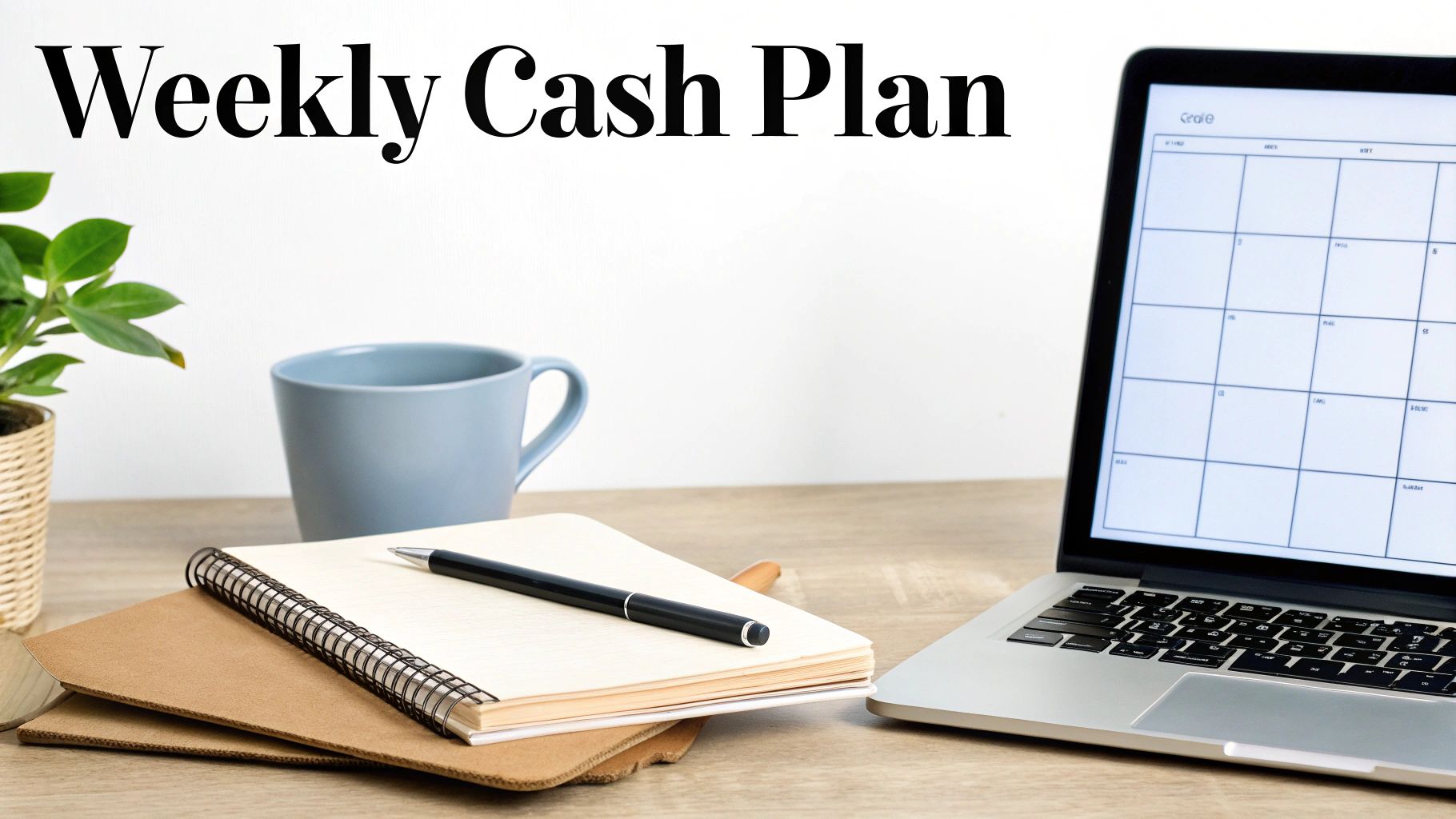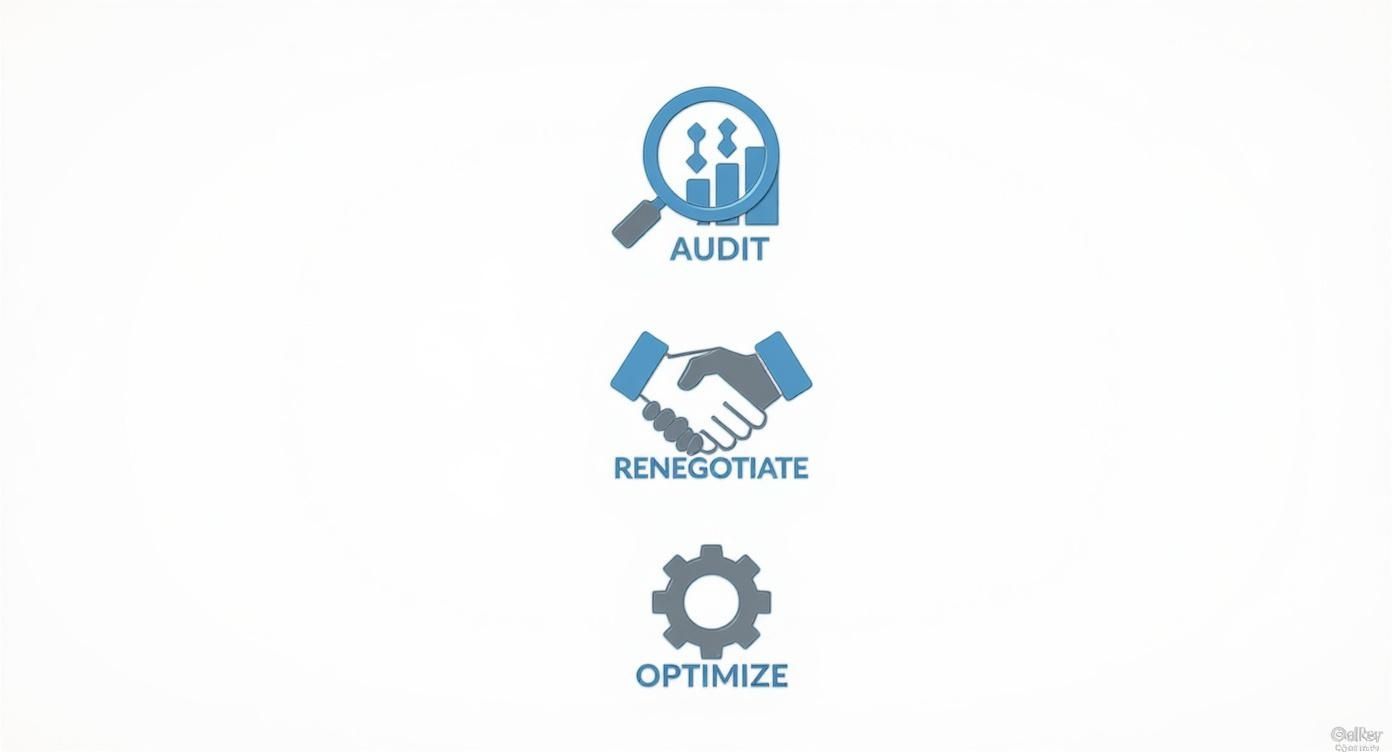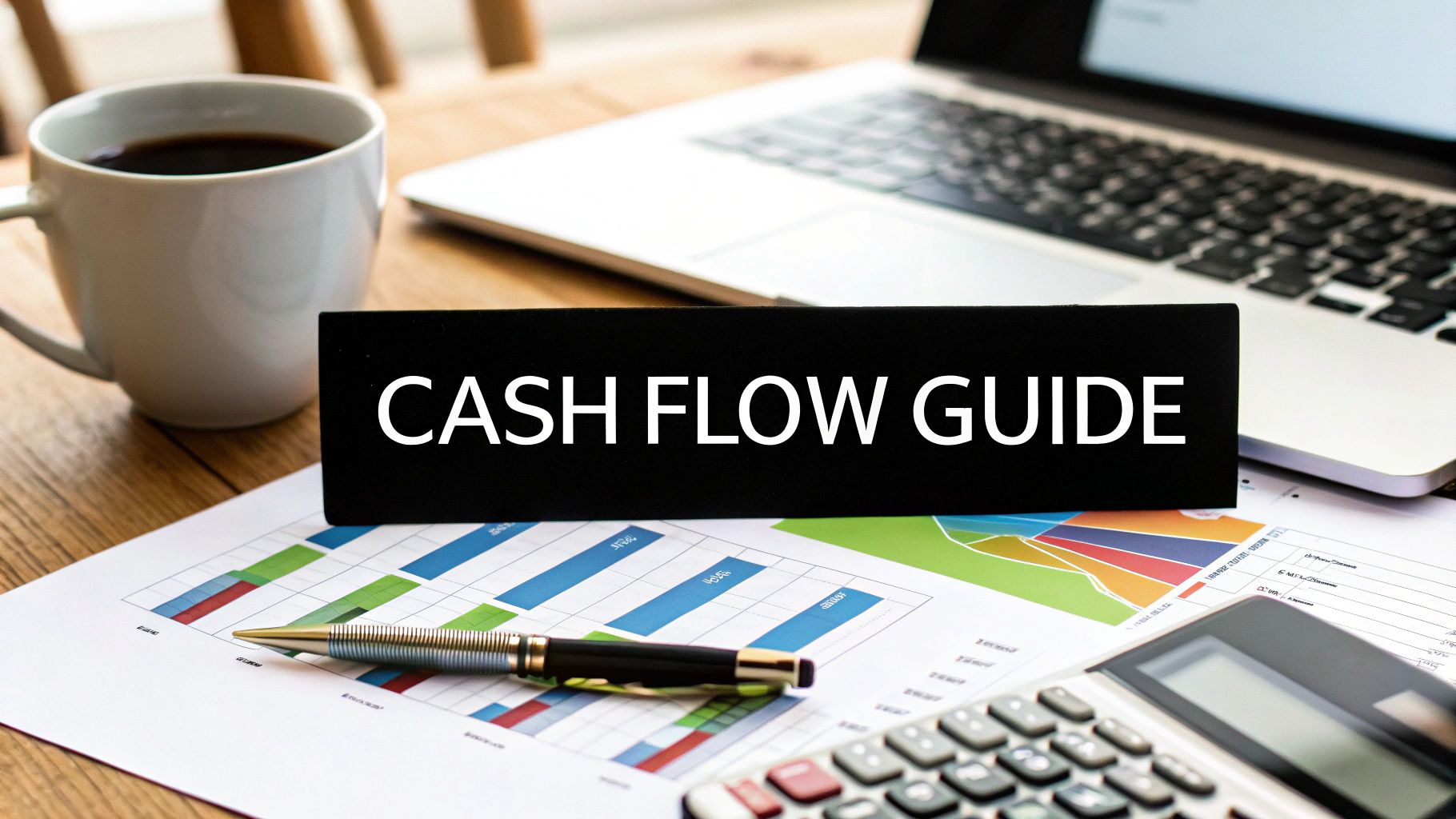Managing the cash flowing in and out of your business is one of the most critical things you'll do as an owner. It's the daily discipline of tracking, analyzing, and fine-tuning your finances to make sure you always have enough money on hand to pay the bills, your team, and invest in real growth.
This isn't just about accounting; it's about turning your business plan into a living, breathing reality. I've seen countless profitable businesses go under, not because they weren't making sales, but because they simply ran out of cash.
Why Cash Flow Is Your Business's Lifeline

It's easy to get fixated on profit. After all, that's the number that tells you if your business idea is working. But here’s the hard truth: profit doesn't pay your rent. Cash does. Cash flow is the actual money sitting in your bank account, the fuel that keeps the engine running every single day.
A company can look incredibly successful on paper, with high profits and impressive revenue, yet still be teetering on the edge of a cash crisis. This gap between the income you’ve earned and the cash you have is a trap that catches too many entrepreneurs off guard.
The Dangers of the Cash Gap
This "cash gap" happens when your bills are due before your customers pay you. It’s a classic small business dilemma.
Let's say you run a growing digital marketing agency and you just signed a dream client. You send them an invoice for $10,000 for the first month's work—a huge win! But their accounts department has 90-day payment terms.
Meanwhile, your team's payroll is due next week, your software subscriptions are auto-renewing, and rent is coming up. Your profit and loss statement looks fantastic, but your bank account is dangerously low. This is the cash gap in action.
And it’s not some rare, unlucky scenario. Cash flow problems are everywhere. One survey found that 72% of small businesses in the UK and a staggering 87% in Australia have faced these issues in the last year alone. That kind of pressure makes it impossible to pay yourself, let alone fund the operations that will help you grow.
"Profit is an opinion, cash is a fact." This old business saying has stuck with me for years because it’s brutally honest. Your P&L statement shows potential, but your cash flow statement reveals your ability to survive right now.
How Your Business Model Shapes Cash Flow
Your business model and marketing plan are directly linked to the rhythm of your cash flow. A retail store might see a huge cash injection during the holidays but then face a brutal sales slump in January and February. If that holiday cash isn't managed wisely, the business might not make it through the Q1 drought.
This is precisely why getting a handle on your cash flow is non-negotiable. It gives you the stability to run those big marketing campaigns outlined in your plan, hire that key employee, and scale your operations without constantly looking over your shoulder.
Understanding the why is the first step. Next, you have to get practical. For a deeper dive, you can master various aspects of small business cash flow management and learn the specific tactics that work.
To get started, it helps to break cash flow management down into its most essential components. I always advise new entrepreneurs to focus on three core pillars.
Core Pillars of Cash Flow Management
| Pillar | Impact on Your Business Plan | Your First Action Step |
|---|---|---|
| Cash Flow Forecasting | Helps you anticipate future cash shortages or surpluses, so you can plan for big expenses or investments outlined in your business and marketing plans. | Create a simple 13-week cash flow forecast in a spreadsheet. List all expected income and all fixed/variable expenses. |
| Managing Receivables | Directly shortens your cash conversion cycle, getting money from customers into your bank account faster. | Review your invoicing process. Can you require upfront deposits? Offer a small discount for early payment? |
| Controlling Payables | Gives you control over your cash outflows, ensuring you don't pay bills too early and tie up needed funds. | Organize all your bills by their due dates. See if any larger suppliers offer longer payment terms to ease pressure. |
Thinking about your business through these three lenses will give you a powerful framework for making smarter financial decisions and building a more resilient company.
How to Build a Practical Cash Flow Forecast

It’s time to move from constantly worrying about money to proactively planning for it. That shift is a total game-changer for any entrepreneur. Think of a cash flow forecast not as some tedious accounting chore, but as your strategic dashboard. It’s a living document that connects your business plan directly to the real money in your bank account, giving you a clear view of the financial road ahead.
Forget those overwhelming, multi-tabbed spreadsheets that take a finance degree to understand. The best forecast is one you'll actually use. For most small businesses, a simple 13-week forecast, updated every week, hits the sweet spot. This timeframe is just long enough to spot upcoming challenges but short enough to stay accurate and actionable.
Projecting Your Cash Inflows
First things first, you need a realistic picture of the money coming in. This is where your business plan's sales goals meet the pavement. Don’t just pull numbers out of thin air; use your own history and your current marketing plan to build an informed projection.
Start by looking at your sales data from the same time last year. This is your best guide to understanding seasonal trends. Are you a landscaper heading into a busy spring, or an e-commerce store gearing up for the holiday rush? Past performance is a powerful indicator of what’s to come.
Next, layer in your marketing plan. If you’re about to launch a new ad campaign, pencil in a conservative estimate of the sales it might bring. Just signed a new client on a monthly retainer? Add that predictable income to your forecast. The key here is to be realistic, even a little pessimistic. Trust me, it’s always better to end up with more cash than you expected, not less.
Mapping Your Cash Outflows
The other half of the equation is tracking your expenses, which is often more straightforward since many of your costs are predictable. A great way to get a handle on this is to split your outflows into two simple buckets.
Fixed Costs: These are the bills that show up like clockwork every month, no matter how much you sell.
- Rent for your office or storefront
- Salaries for your permanent staff
- Software subscriptions (your accounting tools, CRM, etc.)
- Business loan repayments
- Insurance premiums
Variable Costs: These expenses go up or down depending on your business activity.
- Cost of goods sold (COGS) if you sell physical products
- Shipping and fulfillment fees
- Wages for hourly or temporary staff
- Marketing and advertising spend
- Sales commissions
By separating your costs this way, you can instantly see where your money is going. More importantly, you can spot areas to adjust if you see a cash crunch coming. You can't easily change your rent, but you can definitely scale your marketing plan's ad spend up or down based on what your forecast is telling you.
A cash flow forecast isn't about predicting the future with 100% accuracy. It's about creating a system that reduces surprises, helps you make smarter decisions, and puts you back in control of your financial destiny.
This kind of forward-looking planning is your best defense against common financial traps. It's a sobering thought, but around 60% of small businesses admit to struggling with cash flow, often because there's a huge gap between their accounting reports and the actual cash in the bank. A regular forecasting habit helps close that gap, turning your financial data into a reliable tool for stability and growth.
Bringing It All Together: A Practical Example
Let's look at how this plays out for a couple of different entrepreneurs.
Scenario 1: The Freelance Consultant
A marketing consultant maps out her income based on two retainer clients ($4,000/month total) and a new project she feels confident she'll close ($3,000). Her business model relies on low overhead; fixed costs are minimal—just software subscriptions ($200/month) and a home office allowance ($150/month). Her forecast shows a healthy cash buffer, giving her the confidence to invest in a professional development course she’s been eyeing.
Scenario 2: The E-commerce Store Owner
An online shop owner looks at last year's numbers and sees a 20% sales dip is likely over the summer. He projects lower revenue for the next three months. This means his variable costs, like inventory orders and shipping, will also drop. Seeing this potential cash-tight period in his forecast, he decides to delay a planned website redesign. Instead, his marketing plan pivots to a targeted sale to clear out old stock, giving him an immediate cash injection.
Building this forecast is a lot like creating the financial chapter of a business plan, but it’s a dynamic tool you'll use constantly. For instance, putting together a plan for a new coffee shop would lean heavily on these very projections. If you’re looking for a great template, you can check out our guide on building a comprehensive coffee shop business plan.
Think of your forecast as your financial co-pilot. Update it weekly. Compare what you projected to what actually happened. Learn from the differences. This simple habit will transform how you manage your money and empower you to build a more resilient and successful business.
Proven Strategies to Accelerate Your Cash Inflow

Having a solid cash flow forecast is one thing, but actually getting money in the door faster is what keeps your business moving. It’s one of the most direct ways to build financial stability, and it goes far beyond just sending invoices on time. We're talking about a strategic overhaul of how you bill, collect, and even structure your revenue streams as defined in your business model.
Too many small business owners think the sale is complete when the customer agrees to buy. That's only half the battle. The real finish line is when the payment hits your bank account. Every day you wait on an invoice, you're essentially giving your client an interest-free loan.
Fine-Tune Your Invoicing and Payment Process
Let's be honest: your invoicing process has a direct impact on how quickly you get paid. A vague, confusing, or late invoice is an open invitation for a delayed payment. It's time to give your invoicing the same attention you give your marketing plan.
First things first, set crystal-clear payment terms right from the start. "Net 30" is often too generic. Instead, specify the exact due date on the invoice. Make it impossible for anyone to misunderstand when the payment is due. Even better, your business plan and initial proposals should outline these terms so new clients know what to expect.
Then, make it ridiculously easy for people to pay you. The more hoops they have to jump through, the longer you'll wait. Offer a variety of payment options—credit cards, bank transfers, online payment portals. Remove every bit of friction you can.
Your business model shouldn't just define what you sell; it should also define how you get paid. A well-designed payment system integrated into your sales process is a cornerstone of strong small business cash flow management.
Here are a few tactics I’ve seen work wonders for encouraging prompt payments:
- Offer Early Payment Discounts: A small incentive, like a 2% discount for paying within 10 days, can be surprisingly effective. It frames paying early as a smart move for your client, not just a favour to you.
- Implement Late Payment Fees: Your contract should clearly state that overdue invoices will incur a penalty. This isn't about being punitive; it's about setting professional boundaries and discouraging clients from putting your invoice at the bottom of their to-do list.
- Automate Your Follow-Up: Use your accounting software to send automated, polite reminders for upcoming and overdue invoices. This saves you the headache of chasing payments and keeps the process professional.
Reshape Your Business Model for Predictability
Relying entirely on one-off projects is a recipe for a cash flow rollercoaster—a feast one month, followed by a famine the next. A core part of your business plan should focus on building more predictable, recurring revenue. This helps smooth out those jarring peaks and valleys.
If you're in a service-based industry, this could mean shifting your business model from project work to retainer agreements. For example, a web designer could offer a monthly retainer for website maintenance and support. Just like that, unpredictable project income becomes a steady, reliable cash inflow every single month.
For product businesses, a subscription model can be a complete game-changer. Think of a local bakery starting a "Bread of the Month" club or a coffee shop offering a weekly bean subscription. This strategy not only locks in recurring revenue but also builds incredible customer loyalty—a huge win for any marketing plan.
Thinking about revenue this way can also uncover other financial opportunities. For businesses in certain regions, knowing how to tap into things like a quick guide to UAE VAT refunds can provide a significant boost to your cash reserves. These are the kinds of strategic financial moves that go beyond just daily sales.
Ultimately, your goal is to build a business that doesn't just make sales but actively supports a healthy cash flow cycle. By combining a smarter invoicing process with a business plan built on recurring revenue, you take back control of your financial health.
Controlling Costs Without Stifling Growth
When you're managing cash flow, what goes out is just as important as what comes in. A dollar saved is a dollar earned, right? It sounds cliché, but it’s true—and honestly, it's often easier to save that dollar than to earn a new one.
But this isn't about gutting your budget with a machete. The goal is smart, strategic optimization. Reckless cost-cutting is a classic mistake that can choke the very growth you’re trying to fund. You don't want to axe a marketing campaign that’s bringing in great leads or cancel a software tool that’s saving your team hours of grunt work. The real win is finding and plugging the "cash leaks"—those sneaky, unnecessary expenses that drain your bank account without adding any real value.
Start with a Simple Expense Audit
Before you can cut anything, you need a crystal-clear picture of where your money is going. It's time for a little financial forensics. Pull up your last three months of bank and credit card statements and start categorizing every single transaction.
This simple audit is often an eye-opener. What you think you're spending and where your money actually goes can be two very different things.
As you go through each line item, ask yourself a few tough questions:
- Does this expense directly support my business model and marketing plan? Your CRM is probably a yes. Those three different project management tools? Maybe not.
- Is there a cheaper way to get the same result? Sometimes, a leaner tool or an open-source alternative can do the job just as well as an expensive enterprise-level subscription.
- Is this a 'must-have' or a 'nice-to-have'? Be brutally honest. That subscription box for the office breakroom might be fun, but is it essential?
This process almost always reveals a few quick wins. For most small businesses, the cash cushion is surprisingly thin. Data shows the average small business has only 27 days of cash reserves on hand. That's a tightrope walk. Every dollar you save with an audit goes directly toward building a stronger financial safety net. You can discover more insights about cash flow trends on shishirkhadka.com.
Turning Your Audit into Actionable Savings
Once you've spotted the potential cuts, it's time to make them happen. The key is to prioritize. Go after the changes that will have the biggest impact without disrupting your operations or stunting your growth.
Renegotiate with Your Key Suppliers
Your vendors value your business, especially if you're a long-term, reliable customer. Don't be afraid to pick up the phone. A friendly conversation can go a long way.
Ask if they offer a 5-10% discount for early payment. Or, see if they can extend your payment terms from 30 days to 45 or even 60. A simple change like that can immediately improve your cash position without costing you a dime.
Trim the Fat from Your Marketing Spend
Take a hard look at your marketing plan's budget. Are you still pouring money into an ad platform that isn't delivering a decent return? It's easy to fall into a "set it and forget it" mindset, but that's a classic cash leak. Pause the underperformers and reallocate that budget to the channels you know are working.
Case Study in Action: A small digital marketing agency I worked with did this exact audit. With just five employees, they discovered they were paying for overlapping software subscriptions that cost them nearly $800 a month. They consolidated to a single, more powerful platform and also renegotiated terms with a key freelance contractor.
The result? They cut their monthly overhead by 15%. That freed up over $1,000 a month, which they immediately reinvested into their top-performing Google Ads campaign as outlined in their marketing plan, boosting qualified leads.
That's what this is all about. Strategic cost control isn't about shrinking your business—it’s about fueling it more intelligently. When you plug the leaks, you give your business the breathing room and resources it needs to thrive.
Finding the Right Cash Flow Tools for Your Business
I get it—the thought of managing cash flow can feel overwhelming. For years, we were all stuck with clunky spreadsheets, but thankfully, technology has caught up. The right software can completely change the game, turning a reactive chore into a proactive, strategic part of your business plan.
It's not just about tracking what's already happened. It’s about getting a crystal-clear, real-time view of your finances so you can confidently fund your marketing plan and make smart growth decisions. The key is finding a tool that actually fits your business model. A freelance designer has vastly different needs than a small retail shop managing inventory, so one size definitely does not fit all.
Accounting Software with Cash Flow Features
For most small businesses I work with, the best starting point is the accounting software they already use. Powerhouses like QuickBooks, FreshBooks, and Xero have grown far beyond basic bookkeeping. They now pack in some seriously useful cash flow management features.
These platforms sync directly with your bank accounts, giving you a live dashboard of your company's financial health. With just a few clicks, you can see who has paid you, what bills are coming up, and generate an up-to-date cash flow statement. This automation is a massive time-saver and, more importantly, it cuts down on human error, giving you data you can trust.
Just look at this Xero dashboard. It gives you a quick visual snapshot of your cash in and out, which is perfect for making those faster, day-to-day decisions.

The real magic, though, is how these tools solve common cash flow headaches for you:
- Chasing late payments? They can send automated, polite invoice reminders on your behalf. This simple feature can drastically shorten your collection times without you having to play bad cop.
- Worried about paying bills too early? You can schedule vendor payments to go out right on their due date, letting you hold onto your cash as long as possible.
- Spotting trends? Simple reports can highlight seasonal cash flow patterns, helping you figure out the best times to ramp up your marketing budget or when to tighten the belt.
Dedicated Cash Flow Forecasting Platforms
At some point, your business might outgrow the basics. As you add new services, hire staff, or take on bigger projects, your financial picture gets a lot more complicated. This is when a dedicated cash flow forecasting tool becomes a worthy investment.
Platforms like Float, Helm, or Jirav are built for one thing: giving you a deep, forward-looking view of your cash. They pull data from your accounting software but layer on powerful analytical and predictive capabilities.
This is where you can start playing "what-if." What happens to our cash reserve if we hire a new developer? What’s the impact if our biggest client pays 30 days late? Can we afford that big marketing campaign next quarter? These tools let you stress-test your business plan against real-world scenarios.
A dedicated tool empowers you to move from simply reviewing past performance to actively shaping your financial future. It turns your cash flow forecast into a dynamic, strategic asset for guiding your business.
Finding the right software can feel like a big decision. I've worked with dozens of entrepreneurs and have seen firsthand what works for different business types. To help you navigate the options, I've put together a quick comparison.
A Comparison of Top Cash Flow Tools
This table breaks down some popular software to help you find the best fit for your business needs and budget.
| Tool | Ideal for This Business Model | Standout Cash Flow Feature | General Pricing |
|---|---|---|---|
| Xero | Service-based businesses, freelancers, small agencies | All-in-one accounting with a clear, visual cash flow dashboard. | Starts around $15/mo |
| QuickBooks Online | Retail, e-commerce, businesses with inventory | Robust cash flow forecasting and budget vs. actuals reporting. | Starts around $30/mo |
| Float | Growing agencies, consulting firms, project-based businesses | Scenario planning and detailed project-level cash forecasting. | Starts around $79/mo |
| Helm | Any business needing daily cash management and "what-if" analysis | Visual, intuitive, and calendar-based cash flow visualization. | Starts around $25/mo |
Ultimately, the goal isn't just to pick some software; it's to choose a solution that gives you the confidence and clarity to lead your business forward.
If you're still in the early stages and building your financial strategy from the ground up, our comprehensive business plan starter pack provides the foundational guidance that will make any tool you choose even more powerful.
The Cash Flow Questions Every Small Business Owner Asks
When you're running a small business, certain financial questions tend to bubble up again and again. These are the worries that can keep you staring at the ceiling at 2 a.m., wondering if you’re making the right calls. Let's tackle these common questions head-on with some straight-up, practical answers you can put to work.
How Often Should I Really Be Looking at My Cash Flow?
Honestly, for most small businesses, a weekly review is the sweet spot. It's frequent enough to spot trouble before it snowballs but not so often that it becomes a burden. Think of it as your quick financial pulse-check—a chance to see what’s come in, what’s about to go out, and whether you're still on track.
Now, if you're running a business with a ton of daily transactions, like a busy coffee shop or an e-commerce store, a quick daily check-in is a smart move. This doesn't have to be a deep dive; even a five-minute glance at your bank balance versus your immediate payables can save you a world of headaches.
No matter what, you absolutely must do a thorough review at least once a month. This is when you pull up your cash flow forecast and compare it to what actually happened. The magic isn't just in seeing the difference; it's in understanding why. Did that new marketing plan bring in cash faster than you thought? Did a big supplier payment get delayed? Use these nuggets of insight to make your next forecast even sharper.
What’s the Real Difference Between Profit and Cash Flow?
This is the big one. If you only master one financial concept, make it this one. It’s the key to understanding why a business that looks successful on paper can still be struggling to keep the lights on.
Profit is what you see on your P&L statement. It's the classic formula: Revenue – Expenses = Profit. It tells you if your business model is fundamentally sound over a period of time. But here's the catch: it includes things that aren't cash, like depreciation, and—most importantly—it often includes revenue you haven't been paid yet (hello, unpaid invoices!).
Cash flow, on the other hand, is the actual, tangible money moving into and out of your bank account. It’s the lifeblood of your day-to-day operations. It answers the most gut-level question for any founder: "Can I make payroll on Friday and pay my rent on the first?"
A business can be wildly profitable and still go under simply because it ran out of cash. For day-to-day survival and the ability to fund growth, cash is king.
Your business plan might project a banner year for profits, but if you don't have the cash on hand to fund the marketing plan needed to generate those sales, the whole strategy can grind to a halt.
I See a Cash Shortage Coming. What's My First Move?
That moment of dread when you see a potential cash gap in your forecast is tough, but panic is not a strategy. The trick is to act immediately and with a clear head. Don't wait for the problem to hit your bank account.
Here’s what to do, in order:
-
Triage your payables. First things first, look at all upcoming bills. Your absolute non-negotiables are payroll and payments to mission-critical suppliers—the ones you literally can't operate without. Everything else gets moved to the "maybe later" pile for now.
-
Get on the phone. Don't just send another automated invoice reminder. Personally call the clients with the biggest overdue bills. A friendly, professional conversation is shockingly effective at shaking loose a payment that an email might not.
-
Freeze all non-essential spending. This is where discipline pays off. That new equipment you were eyeing? Pause it. The experimental campaign in your marketing plan? Shelve it. Go through your expenses line by line and ask one simple question: "Is this absolutely vital for generating revenue right now?"
-
Activate your safety net. If you have a business line of credit, now might be the time to consider using it. If you don't have one, start looking. The best time to secure financing is when you aren't desperate for it. Having it in place provides a critical buffer for navigating these bumps in the road.
Getting a handle on these questions is a huge step, but the learning never really stops. For a deeper dive into other common challenges, we've compiled a ton of information in our comprehensive small business FAQ.
Ready to turn your business idea into a powerful, actionable strategy? GrowthGrid uses advanced AI to help you create a detailed and professional business plan in under 15 minutes. Stop guessing and start planning with confidence by visiting https://growth-grid.ai today.
